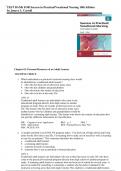Exam (elaborations)
TEST BANK FOR Success in Practical/Vocational Nursing 10th Edition by Janyce L. Carroll , ISBN: 9780323810173 Chapters 1-19 || Complete Guide A+
- Course
- Institution
- Book
Test Bank For Success in Practical Vocational Nursing 10th Edition Carrol Collier 9780323810173 Chapter 1-19 Complete Guide.UNIT I RESOURCES 1 Personal Resources of an Adult Learner 2 Academic Resources (Study Skills and Test Strategies) 3 Community Resources UNIT II BUILDING BLOCKS FOR YOUR CAREER...
[Show more]



